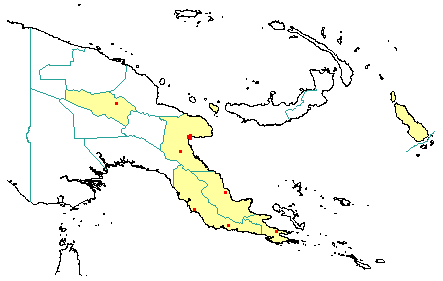
in PNGplants database
PNGTreesKey – Planchonella torricellensis (K.Schum.) H.J.Lam |
Barry Conn (NSW) & Kipiro Damas (LAE).
Guide to trees of Papua New Guinea
Copyright held by the authors, National Herbarium of New South Wales, and Papua New Guinea National Herbarium
Nova Guinea Vol. 14: 562 (1932)
Family: Sapotaceae
Dicotyledon
Timber Group: Major exportable hardwood
Field Characters: Large canopy tree (up to 40 m high); Bole cylindrical (up to c. 80 cm diam.); straight (bole up to c. 22 m long); buttresses buttresses present (buttresses up to 2 m high); spines spines absent; aerial roots aerial roots absent; stilt roots stilt roots absent; Bark brown or purplish, rough, fissured or pustular, lenticels elongated vertically (within fissures); Subrhytidome (under-bark) brown or mottled; less than 25 mm thick, 9.0-16.0; bark blaze consisting of one layer; faintly to non-aromatic; outer blaze pink or brown, with stripes, granular with splinters (white to yellow-brown streaks); inner blaze pink or brown, with stripes, granular with splinters (white to yellow-brown streaks); bark exudate (sap) present, white/milky, not readily flowing (spotty), colour not changing on exposure to air, sticky; terminal buds not enclosed by leaves.
Indumentum: Complex hairs absent; stinging hairs absent; mature twig indumentum (hairs) absent.
Leaves: Leaves spaced along branches, spiral (leaves occurring singly at a node and arranged spirally up the branchlet), simple (a leaf composed of a single blade); petiole present, not winged, attached to base of leaf blade, not swollen; leaves broadest above middle or broadest at or near middle, 7.0-20.0 cm, (1.5-) 3.0-7.5 cm; symmetric, entire, not dissected or lobed, obtuse, sub acute, or acuminate, venation pinnate, secondary veins open, prominent, intramarginal veins absent; leaves lower surface pale green or green, upper surface dark green (dull (to subglossy), indumentum (hairs) absent; absent; domatia absent; stipules absent.
Flowers: Inflorescence axillary or on the trunk or branches (particularly, arranged on branchlets below leaves), flowers arising from a single point, cones absent; flowers bisexual, stalked, flowers with many planes of symmetry, 6.0 (c.) mm long, diameter small (up to10 mm diam.) (c. 6 mm diam.); perianth present, with distinct sepals and petals whorls, inner perianth yellow, pale green, or cream-coloured; 5, some or partly joined; stamens 5, present, free of each other, joined to the perianth; ovary superior, carpels joined (when more than one), locules 5; styles solitary, 1.
Fruits: Infrutescence arising from single point, fruit dark red or purple, not spiny, fleshy, simple, indehiscent, berry; seeds usually 1-5, not winged, broad (as wide as long).
Distribution: Morobe, Western Highlands, Central, Northern, Milne Bay & Bougainville.
 | Botanical records in PNGplants database |
Notes: Notes Pennington, T.D. (1991) The Genera of Sapotaceae (Royal Botanic Gardens Kew & New York Botanical Garden) transferred all species of Planchonella to the genus Pouteria. Therefore, he regarded this species as Pouteria torricellensis; however, it is here retained in the genus Planchonella until the results of further molecular work resolve the taxonomic status of these two genera.